Last July I retired at the age of 71. My work involved aviation and therefore I spent a lot of time in “the big tin can at the top of the world”. I’ve also been passionate about photography since the mid-sixties. I first started using Leica cameras in 1969 and have therefore taken cameras on most flights.
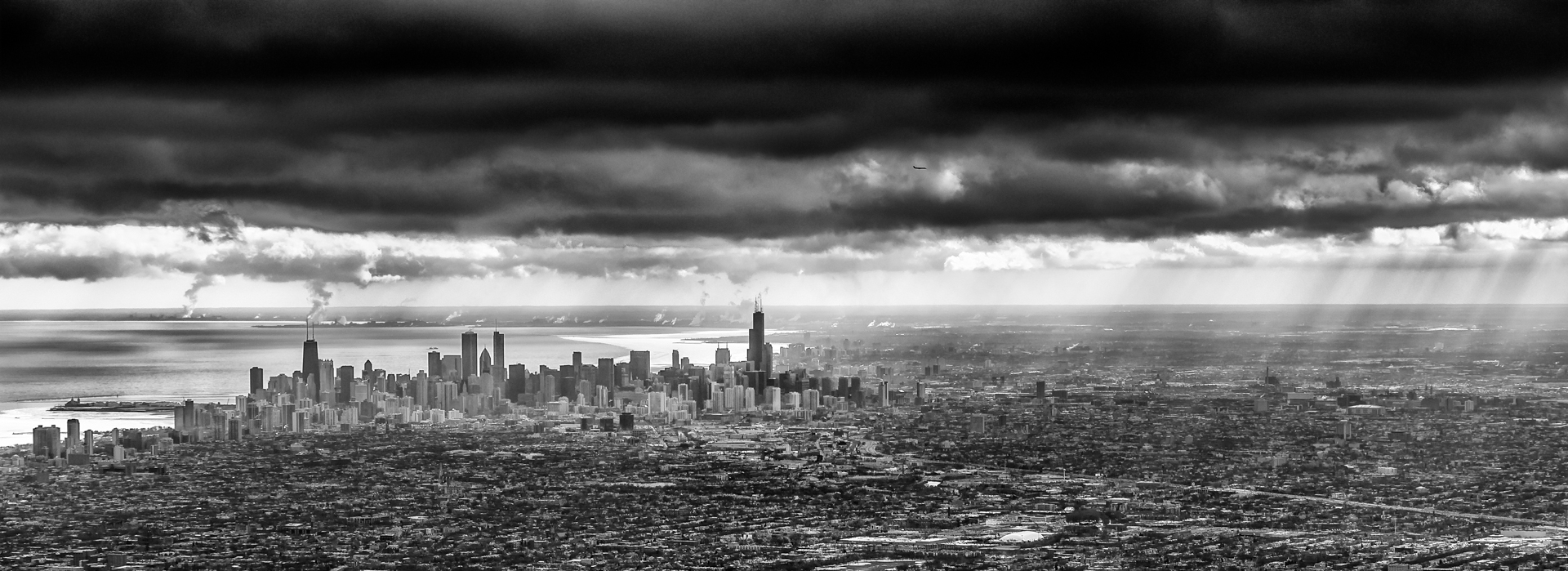
“Chicago Approach” was taken from a United Airlines Airbus A320 on a flight from Seattle to Chicago. As we decended into Chicago, the weather deteriorated and it was extremely bumpy, which made me think that once we got through the cloud there could be a dramatic sky. So I got the camera out. Sure enough, I was delighted with the captured image. A large print also shows another aircraft on a parallel approach to us which, for me, makes the photograph.
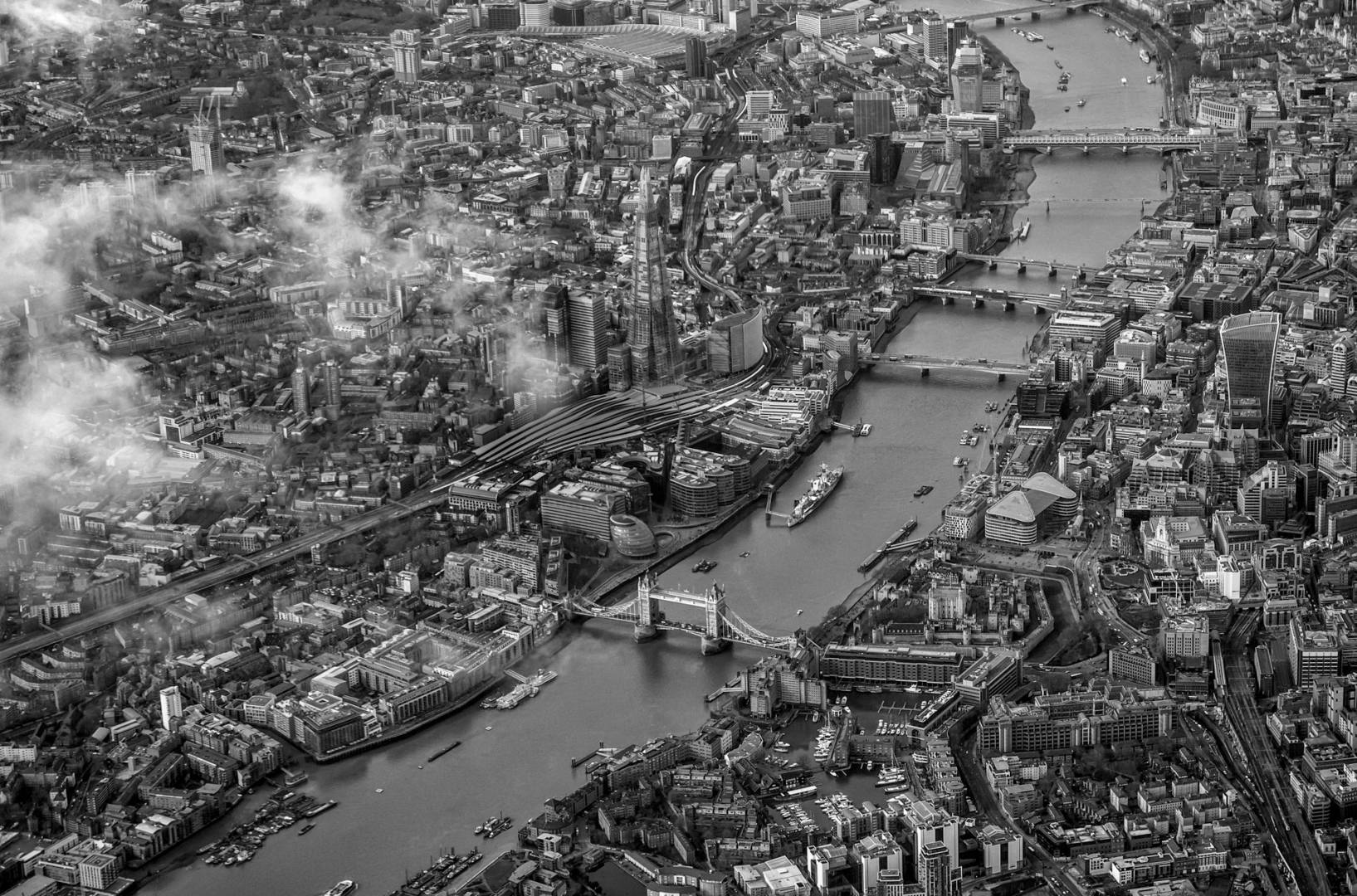
Heathrow approach
“Heathrow Approach” was the complete opposite, with perfect flying conditions. I had been working with Air India in Mumbai (I still think of it as Bombay) and had helped them get a Boeing 787 back in the air. When I checked in for the “silly o’clock” flight back to Heathrow, they gave me seat 1A. As we approached Heathrow the following morning, we went into the usual holding pattern and I snapped a couple of images
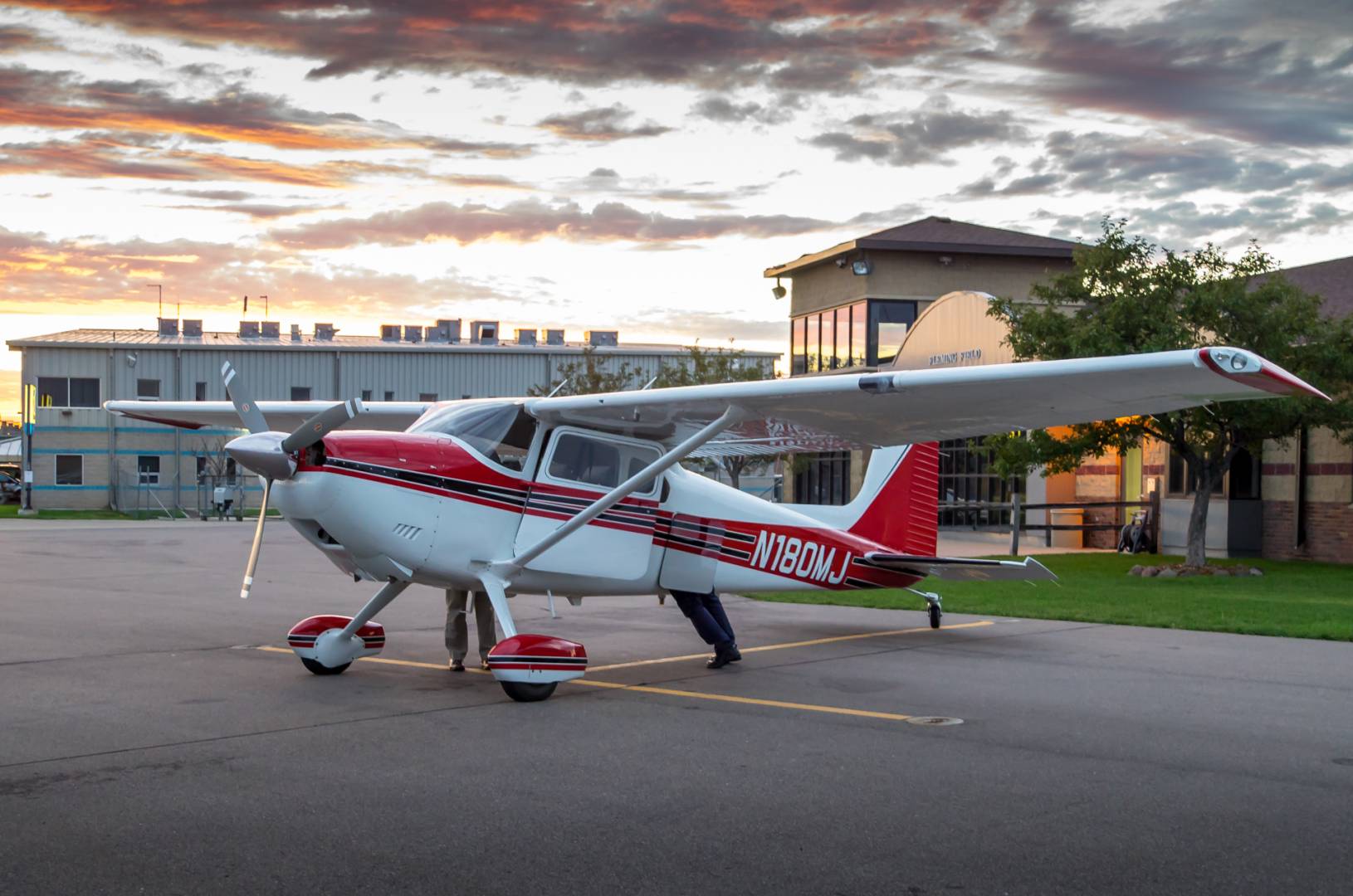
I have captured many other images from commercial airliners but some of my favourites are those taken from a friend’s immaculate 1955 Cessna 180.
Weather worries
Mike and I had attended an aviation conference in Minneapolis and he had decided to fly the Cessna there from his base in Reno, Nevada. Having been tied up in a hotel conference room for five days, we decided to take the Cessna for a spin one evening.
We had intended to land in some small town about 45 minutes from Minneapolis, have dinner and then return. However when we got there the weather had closed in and we were worried that the fog would be too thick for a take-off after dinner. So, reluctantly, we headed straight back. The sunset on our return flight certainly made the effort most worthwhile.

In February a couple of years ago, I had been involved in teaching a “Damage Assessment & Structural Composite Repair Course” (sounds fun, doesn’t it?) which involved me spending a weekend in Reno, Nevada.
Yosemite
I love Yosemite National Park in California and the local guys knew that’s where I would be heading to spend the weekend. They realised I’d been there many times and so, for something different, they suggested I should photograph it from the air. Of course I jumped at the chance and, early on Saturday morning, we loaded the faithful Cessna.
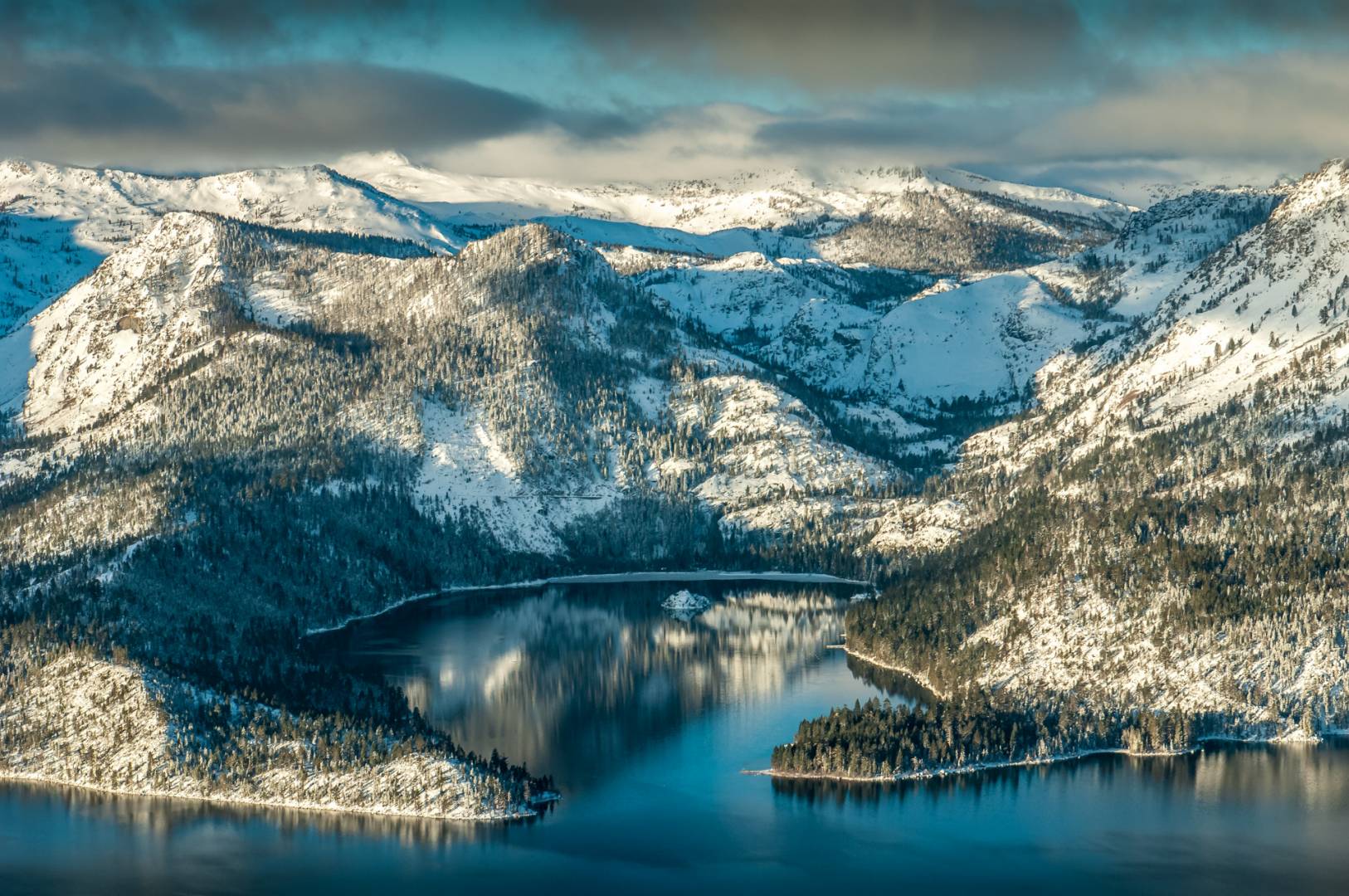
The initial flight plan took us over Lake Tahoe and I grabbed this shot of Emerald Bay using a Nikkor 28-70mm f/2.8, set at 62mm, with 400 ISO. If I remember correctly, I also used a polariser and three-stop graduated filter.
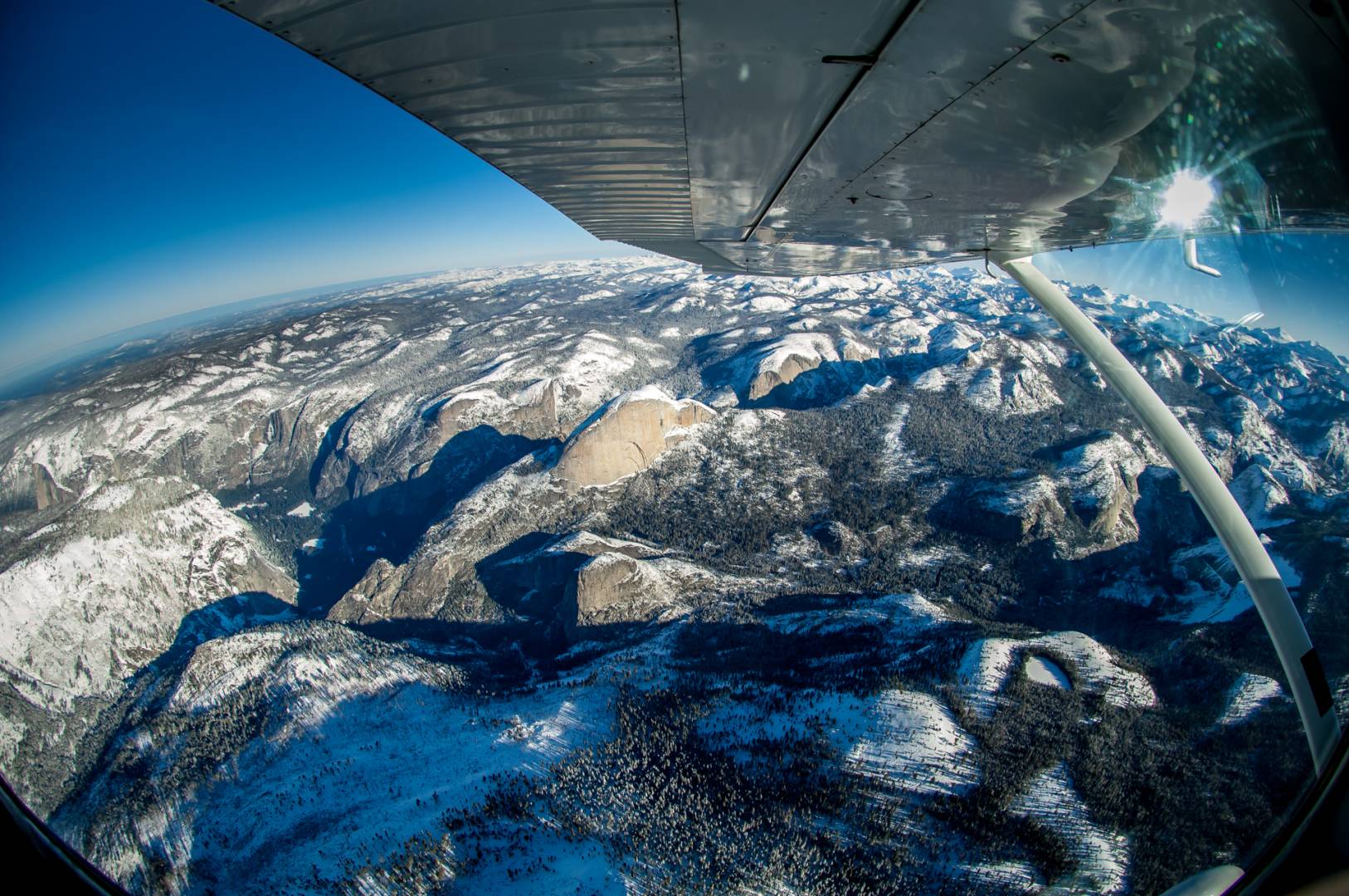
The first place I recognised as we approached Yosemite was the “back” of Half Dome, not normally seen unless one goes up to Glazier Point. I used a 10.5mm fisheye lens since I wanted to exaggerate the curvature of the earth and produce something a little different.
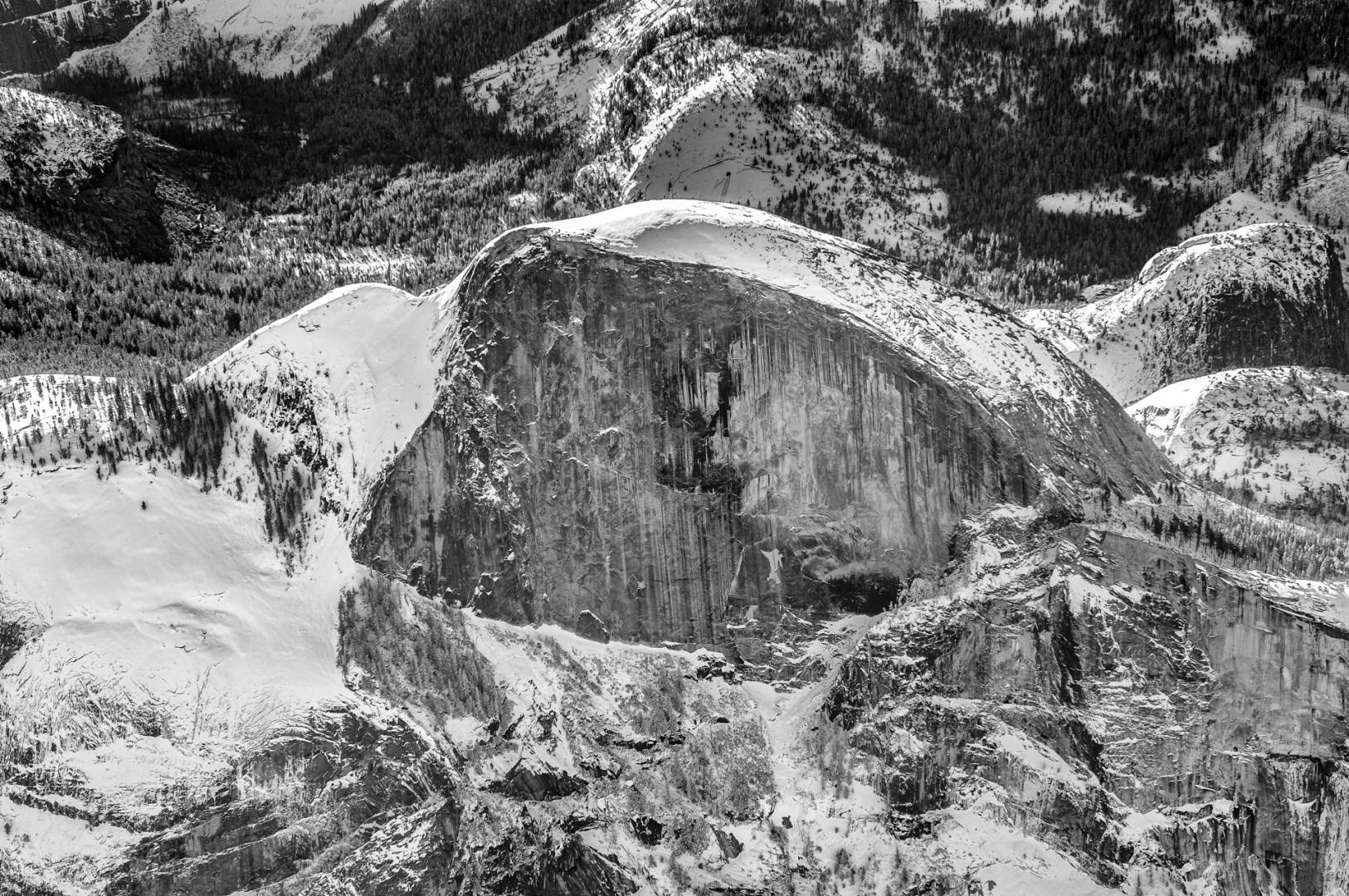
We circled Half Dome a few times, but not for too long as we didn’t want to disturb the peace and tranquility on the Valley Floor. Being Yosemite, this image had to be black & white, as are all the prints I’ve produced from this wonderful area.
Fisheye
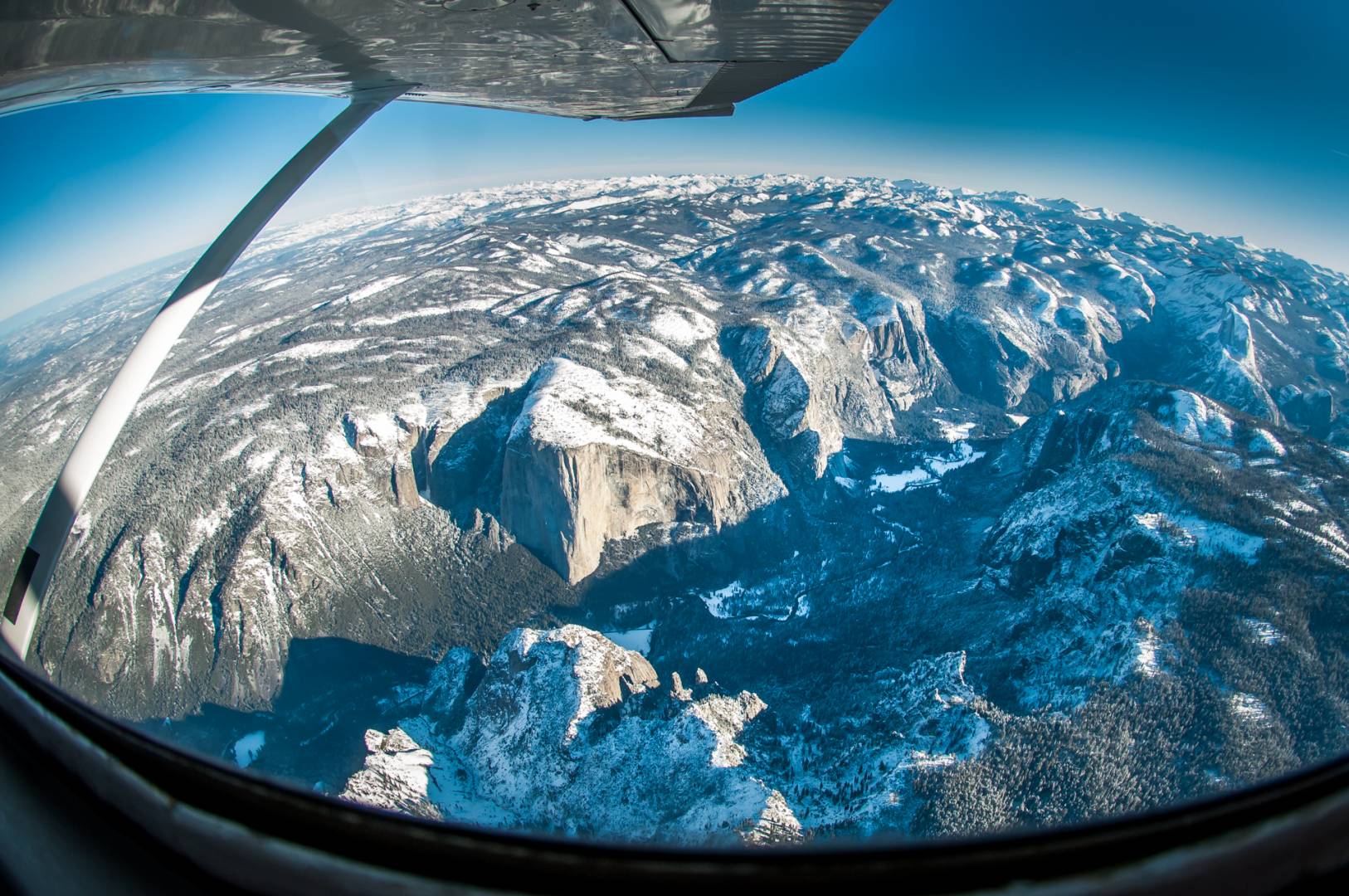
Mentioning the Valley Floor, before we left and headed back to Reno I took another fisheye image, this time of the valley, with El Capitan in the foreground and just visible at the right centre of the image is Half Dome.
Yosemite is a landscape photographer’s paradise and I’ve been lucky to have visited it many times and during most seasons of the year. The summer colours are spectacular, but the number of tourists can make photography difficult; my favourite time is winter but the heavy snows do restrict access to some of the higher passes. In fact it was only on our fifth, or even sixth visit that Tioga Pass was actually open. We’re off there again at the end of November and, as it coincides with Thanksgiving, are hoping the park will be relatively visitor-free.
I hope you have enjoyed my brief insight into aerial photography and it may have inspired you to keep a camera ready next time you’re in “the big tin can at the top of the world”. You don’t need anything special, but I would advise you to get the camera lens as close to the window as possible (without actually touching it) in order to avoid any unpleasant reflections.

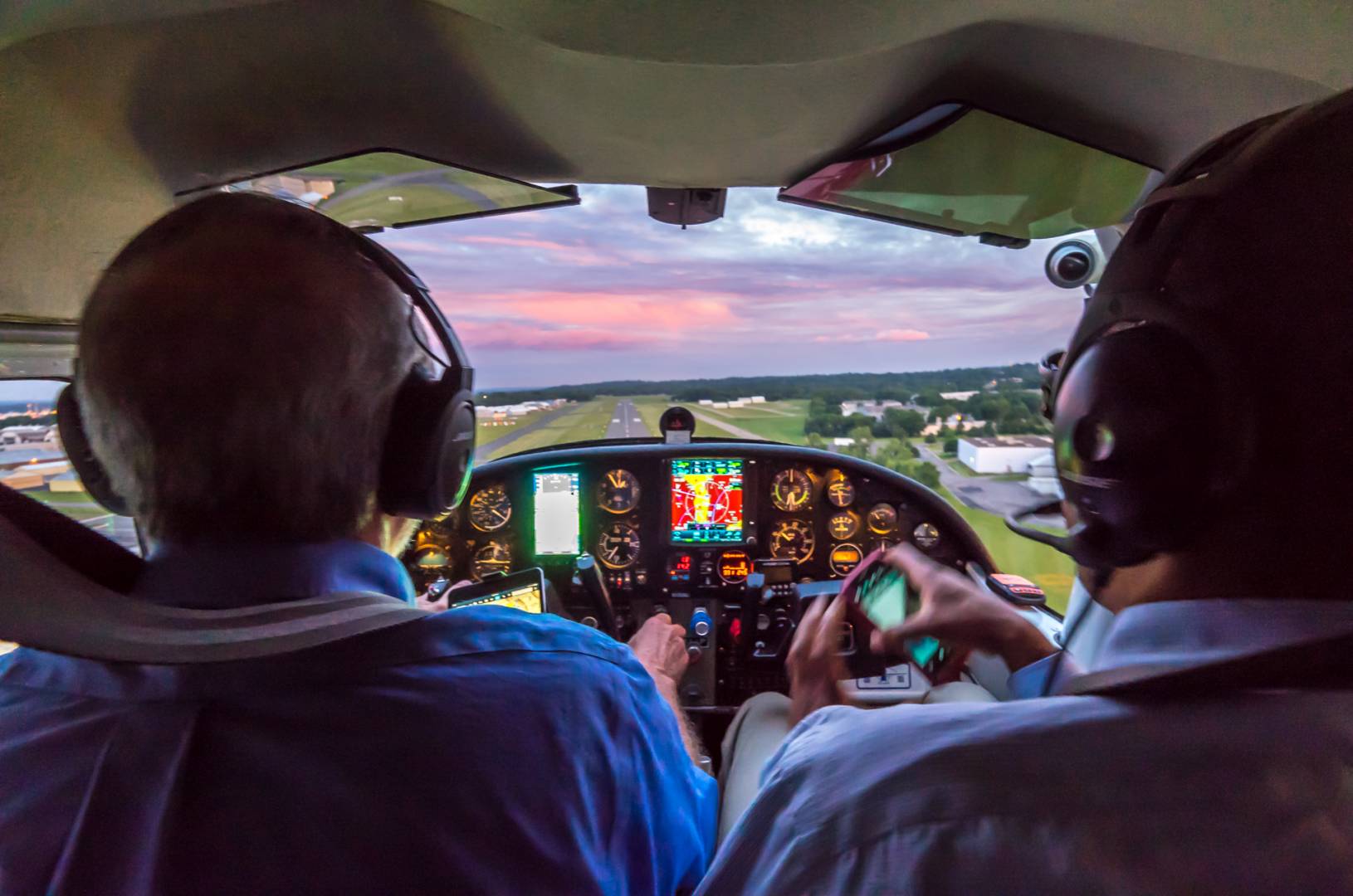
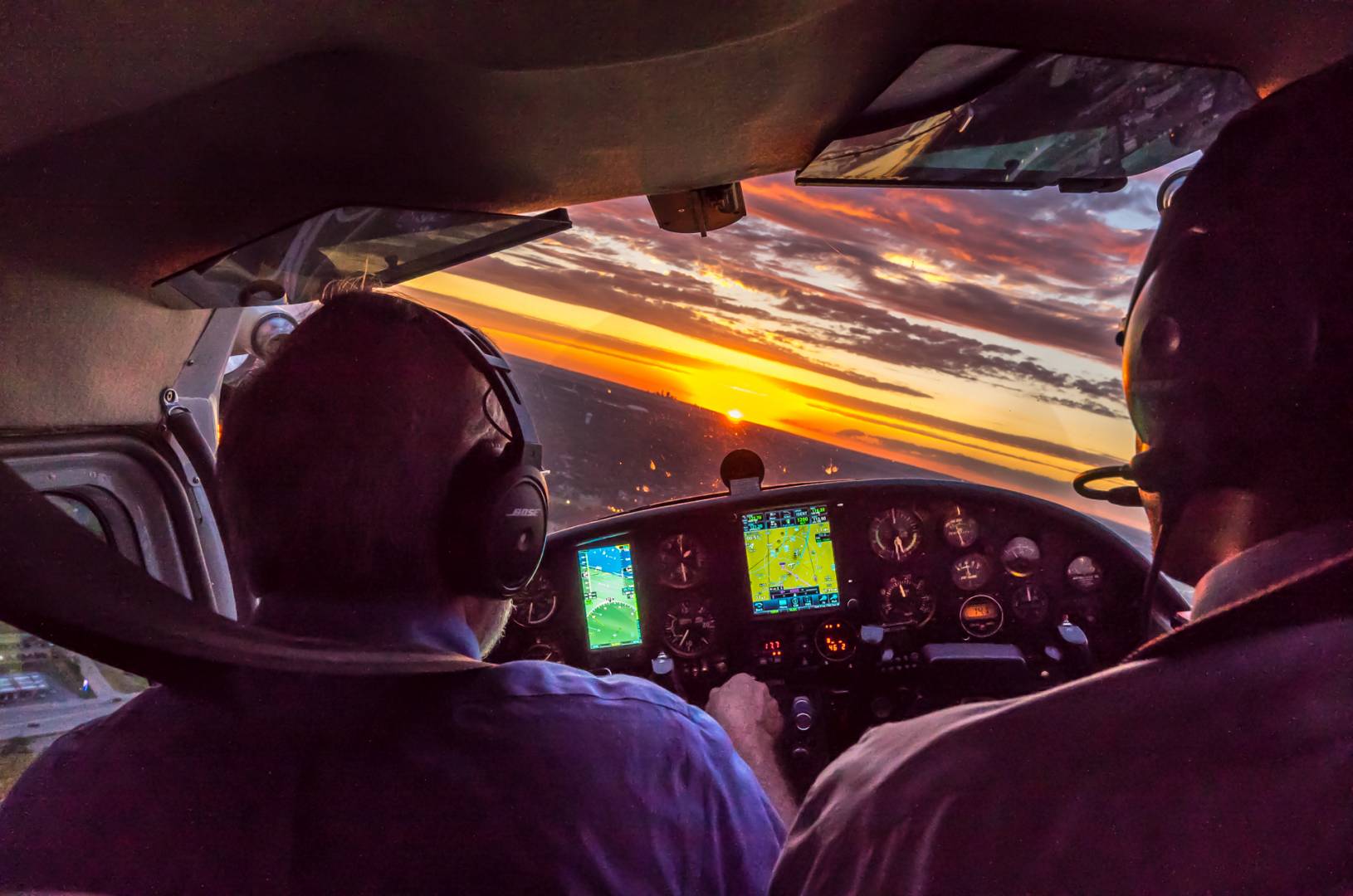
Hi Tom,
Thank you for sharing your photos, I love the “Chicago Landing”! Everything just come together on this picture: the gloomy skies and crepuscular rays make it dramatic, the panorama highlights the cityscape and the B&W gives the classic feel. It will be a very nice piece of art to hang on a large wall! I never work in the aviation industry but my profession does have a unique relationship with it. I write Terminal Aerodrome Forecast (TAF) for selected airports, a vital piece of information for both the pilots and control towers during take off and landing. I do have interest in flying but as Dave pointed out, it is just too expensive to get a pilot license nowadays.
Living on the small island of Guam, I travel regularly too keep my sanity in check. The next time I am on the plane, I will keep my CL and the 18-56mm lens handy. Happy Thanksgiving to you and your family, and other Macfilos readers in the US!
Yours Truly,
Patrick
Thanks for the kind comment John. After working so long I’m finding retirement difficult to get used to, that’s why I responded to Mike’s request when he asked me to try and write an article.
Have you considered writing a book Tom documenting all your working travels and achievements?
Or… write it bit by bit as separate articles (for Macfilos) and then publish the compendium as a book!
Let’s not get overambitious. However, I wouldn’t mind doing another article for you when you’re ready. This time maybe on Yellowstone.
Cheers, Tom
I must admit Dunk, I have thought about it as I’ve had a few “experiences’. Was on a London to Cairo B747 when there was a suspected bomb scare on board, another bomb scare at the Sheraton Hotel in Kuwait City, evacuated from Jordan in 1967 to name a few.
Achievements would be more difficult.
Tom, congratulations great photos and an interesting story.
Now thousands, maybe even tens of thousands, of flights later you have me wishing that I had taken more photos from the air. It’s not too late but so many great opportunities missed. I do have some good shots but too many times I forgot to take my camera down from the overhead locker before the seat belt sign came on as we were landing or often the windows were badly scratched.
Enjoy your retirement. I heartily recommend it.
This is a wonderful series Tom, with a unique point of view. I once flew Cessnas, but never over national parks or big cities, so even for an amateur pilot, what you have to show is exciting.
Cheers Dan, never realised you flew. Look forward to catching up in Cheltenham, or maybe someone (Pete) will arrange a London walk between Christmas and New Year.
Hi Tom,
That first image is absolutely stunning, and if it was mine I would have it on a canvas adorning one of my room walls.
I also like the images shot between the pilots and co-pilot in the small cessna, I once had the ambition to be a pilot and had a few flights in one of these as a view to training up to do my licences. But in reality, cost, keeping a roof over my family and my growing kids at the time meant it ended up as an ambition that I will never fulfill as my career has taken over now.
I wouldnt mind seeing more images from your collection if they are this good.
Enjoy the weekend.
Dave
Thanks for the kind comment Dave. Yeah, flying is like a money pit. Although I’ve been involved with aviation for most of my working life, I’ve never had any desire to “drive the thing”. Much rather sit reading with a gin and tonic. Cheers
All of the images are wonderful but I find the first image so breathtaking. I am sure you are going to miss those Max planes that can challenge flying skills.
This was a truly unique article and please show more!
Thanks for your kind comment Brian. Thankfully I was only involved with structures and flight controls and not the flight management systems. Far too clever for me.
Superb images Tom. I’ve tried a few shots from a Dragon Rapide … Only one was a keeper.
dunk
Thanks for the kind comment Dunk. Maybe catch up in Cheltenham.
Thanks Tom for this fascinating and unusual article, the Chicago Approach photo is one I would like to see full size on a wall. Yosemite is on my wish list.
Thanks for the kind comment Kevin. I’ve printed that one large and have to admit it does work well. You really should get to Yosemite, it’s a great place.
Amazing images, Tom. I Just love the black and white images, the first one in pano mode is great with the sunrays slanting through the clouds. Just a pity that most companies schedule long international flights at night. Thanks for sharing
Thanks for the comment Jean. Fortunately those long international flights arrive early morning when the light is good. The one taken over London must have been taken about 06:00am.
Fabulous pictures thank you so much for sharing them and for the ‘How To’ tips. It makes me ashamed to remember I spent almost my entire working life flying somewhere or other and not only never took shots fro the many airplanes, but never bothered much about taking tourist type shots when I got wherever either. Far too late for me to put matters right now, and I regret it, but at least I can marvel at and enjoy yours. Don
Thanks for your comment Don. It is a shame you missed the opportunity but as they say, “it’s never too late”. What got me enthusiastic was living in Jordan in 1966/67 I got the chance of flying in a six seater Dove aircraft with Wing Commander Gifkins between Amman and Aqaba. As a we approached Wadi Rum he asked if I’d been there and I told him I driven the Land Rover through it many times. He said I should see it from the air, banked the aircraft right over and then proceeded to fly through the valley with the hills above us on each side. Bet you couldn’t do that these days!
Excellent images, Tom, which I have much enjoyed. The colours are gorgeous but then I love the two mono shots of Chicago and London just as much. I also like the reflections on exterior plane surfaces too.
The shots of Yosemite in snow are powerful. I have only visited Yosemite in Summertime but have the happiest memories of two days there (should have taken two months!) and particularly of the calm and serenity of Tuolumne Meadows. In our family, we use “Tuolumne Meadows” as our code for an unforgettable experience wherever we are!
Thanks for the kind comment, David. Yeah, Yosemite is a great place and we’re off there again tomorrow morning. As it’s Thanksgiving this week I’m hoping there will not be too many people there.
Great photos all, but think you should be selling 1,2 to ad or tourist agencies, magnificent. Thank you
Thanks for the kind comment John, I would if I could take your advise. Cheers.
Lovely photos, Tom. Using a Leica from an aircraft has some great tradition behind it going back to the pictures from the 1930s taken by Count Castell-Rüdenhausen (yes, it is a real name!) while flying over China.
Half Dome in Yosemite looks quite small from above compared to the ground shots we are familiar with. We were lucky to have had Alan Ross, who was one of the last darkroom assistants of Ansel Adams, at our camera club some years ago. Among the items in the darkroom was an 8×10 enlarger which could also project an 8 foot vertical image for examination by Adams who was a perfectionist, particularly as regards exposure with his zone system. Adams was not the first person to photograph Yosemite. In the 1860s Carleton Watkins took photos in Yosemite which led to Abraham Lincoln declaring it to be the world’s first preserved area, or national park. Watkins used a Grubb brass lens which was made not far from where I am. His camera rig was massive and he needed a wagon, pulled by 4 mules, to carry it up into the heights of Yosemite.
Attaining heights is not such a problem these days. Leica has gone into the drone business recently with a new range of cameras, but nothing beats a photo taken from normal aviation height. That skyline photo of Chicago is magnificent.
I look forward to seeing you again at the TLS meet in Cheltenham next year.
William
Thanks for the kind comment and story about Count Castell Rudenhausen; bet he didn’t have to worry about dirty windows in those days.
I really admired and am still motivated by Ansel Adams and his monochrome prints. Probably 99% of my prints are black & white and I have two I’m particularly fond of; El Capitan and Snake River which hopefully I’ll get to share some day. My wife asks me why I print in Black & White and of course I say, “it saves money”.
Thanks for the wonderful shots from a different perspective. Particularly happy to see my “Sweet Home Chicago” which regularly delivers spectacular skies. I was surprised to see the other plane as I thought ORD only did twin track when the cloud base was high and with good long range visibility. Could it have been heading into MDW?
Thanks for the kind comment. I always remember my first visit to Chicago. I lived in Singapore at the time and flew to Knoxville regularly. After flying to Hong Kong, or Tokyo I used to get a flight to Chicago which got me in mid-afternoon. As the Knoxville flight was late evening I used to stay at the Hilton which is on the airport and then get a flight around midday. I got in one winters’ day, beautiful day, not a cloud in the sky. When I woke I checked the flight departures and nearly everything had been cancelled because of the cold. I took the opportunity to catch the train downtown. I got out in Michigan Avenue (?) and the cold hit me like a sledge hammer. Coming from Singapore I has no warm clothes and only a pair of Timberland boat shoes on. I didn’t think I was going to make it back to the subway; my feet were so cold I had to buy a pair of boots which probably only ever walked that half/one mile back to the station. Been many times since and really love the city.
There’s a saying in the Midwest “There’s no such thing as bad weather, just bad clothing choices.” We live with several metres worth of coats, boots and shoes to cover every type of weather. I grew up in tropical West Africa so a visit to Singapore should have felt familiar, but that 90% humidity quickly gets you! My wife and I still loved Singapore and walked everywhere to see as much as could be seen and shot with the very portable Leica DL-109.
I was really fascinated by these images. A little peripheral comment to anyone following your advice: Take a little Leica C if you can. One of its scene modes is “through window”, and it works with crystal clarity. Not even the latest Leica compacts seem to have it.
It’s interesting to learn that the Leica C has a “through window” mode, wonder how they do that?
It’s just a auto-focusing mode which will less likely to focus on dusts on the window. The way to achieve this is prioritizing focus at longer range. To remove the blurring image cause by shooting through double-layered aircraft windows is not what this mode can do.
– A350 pilot
Fabulous pictures, all of them. In the shot of Chicago the weight of the cloud cover over the city is palpable. I hope we can see more in future articles?
Many thanks for your kind comment Richard, which is greatly appreciated. Now I’m retired I’ll certainly try to contribute more to the MACFILOS site.